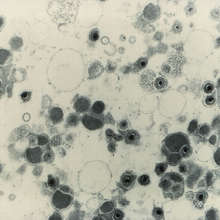*A cohort study is one that follows a group of individuals who differ with respect to specific factor to determine how the factor affects the rates of specific outcomes.
In a large, recent cohort* study in the US, researchers assess the effectiveness of shingles vaccine against incidence of shingles and post-herpetic neuralgia (nerve pain from shingles) among older individuals.
They randomly selected as study participants 766,330 Medicare beneficiaries aged 65 years or more. Medicare is a US government health insurance plan that helps to pay the health care costs of people aged 65 or older.
The researchers used administrative data to identify participants who had received shingles vaccination between January 2007 and December 2009, and those who had developed shingles or nerve pain after having shingles.
People who had the vaccine were much less likely to get shingles. Vaccination reduced the incidence of shingles by 48%, or, the vaccine is 48% effective.The shingles incidence rate was 10.0 per 1,000 person-years among unvaccinated participants and 5.4 per 1,000 person-years among vaccinated participants. However, among immunosuppressed individuals, vaccine effectiveness against shingles incidence was lower, at 37%.
For people who got shingles, those who had the vaccine were less likely to still have pain 30 days or longer afterwards. The effectiveness of vaccine against post-herpetic neuralgia was 59%.
Shingles affects almost a million Americans each year. Vaccination against shingles is now recommended in the US for everyone over the age of 60 except individuals with a weakened immune system (for example, people with HIV/AIDS).
Background
Chickenpox is an extremely common childhood infectious disease caused by the herpes varicella-zoster virus. Children usually recover quickly from chickenpox, but dormant varicella-zoster virus persists throughout life inside the nervous system.
The dormant virus causes no symptoms but if it becomes reactivated, it causes shingles, a painful skin rash. Anyone who has had chickenpox can develop shingles. Shingles is most common and most severe in older people.
About half of people will have an episode of shingles by age 85. Early signs of shingles include burning or shooting pain and tingling or itching. Blister-like sores, which last from one to 14 days, develop in a region of one side of the body or the face. The pain of shingles can be debilitating and can continue after the rash disappears for months to years because of damages to the nerves.
There is no cure for shingles but early treatment with antivirals may help to prevent lingering pain by inhibiting viral replication.

